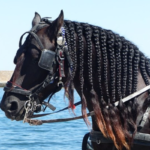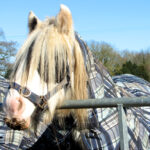Without marking, it is hard to identify horses within a herd. This is why horses have various types of markings. Let’s take a look at different types of horse leg marking.
There are six typical leg markings: stocking, sock, pastern, cornet, boot, and ermine. Leg markings are typically bright white with distinct borders and can appear uniformly on all four legs.
The most visible part of the leg marking of a horse is its highest point that is covered with white. There is no universal definition of leg markings, but they are typically painted on all four legs uniformly, such as four cornets. However, a single horse can also display a mixture of leg markings, such as a stocking and two pasterns.

What are the Different Horse Markings?
Horses have various white patches on their face and legs. These are called horse markings. Let’s examine different types of horse markings in more detail.
What is Coronet Horse Marking?
You must have seen horses with cute little spots of white hair on the hoof. No!! They are not an unusual growth but a leg marking known as a coronet.
The top part of the horse hoof is called the coronet. So, this horse marking is the white hair that extends from a horse’s foot just above the coronet. This is the reason why they are called coronet markings.
They are the most minor horse marking that rises up only for an inch or two. However, in some horses, a coronet covers the entire foot; this may cause the appearance of white hairs on the foot as the whole. If the white hairs are broken by coat color, the rest of the hoof may look dark below the coronet.
What is Stocking Horse Marking?
Ever stared at a horse and wondered why it was half brown, half white. This is not because of their coat color but because of the leg marking they are born with!!
Stockings are the largest and perhaps most prominent white markings. These can extend up to flanks and bellies and can cover half of their body. Being larger in size, they are easily recognizable by most people.
The pattern of these markings can be symmetrical or can extend on a horse leg in a jagged way.
What is Socks Horse Marking?
Socks are among the standard horse leg markings. Let’s examine what sock’s leg markings look like and how they look.
Socks marking starts about two-thirds of the way up the leg. They are also white markings that start at the hoof and extend up the leg.
In most cases, the hoof will be white if the sock is solid white. However, if the coat color is exposed, the foot may appear dark. The unique thing about sock marking is that there are also black markings similar to white markings.
What are Pastern Horse Markings?
Pasterns are the part of a horse’s leg between the hoof top and the fetlock. Pastern marking is named after this horse part. Let’s examine what exactly they are.
Pastern looks similar to coronet marking. The only difference is they overlap the bottom of the hoof, usually one inch above the front of the horse hoof but stop at the starting of the fetlock joint.
Partial patches of white hair are also present on the legs of horses, but they don’t extend all the way around and give irregular appearance.
What is Ermine Horse Marking?
Considering their size and color, ermine markings are regarded as one of the unique horse markings.
They are small spots of black color that appear on a white area just above the hoof coronet band. Ermines markings can also appear on the face of horses and are also considered one of the popular face markings of horses.
What is Boot or Fetlock Horse Markings?
Boot and sock markings are so similar that it is sometimes difficult to distinguish between them. Let’s look at what fetlock markings look like.
Boot or fetlock refers to white hair that extends up to the fetlock joint. Most of the horses have partial fetlocks as well. Partial fetlock refers to just a portion of the fetlock covered by hair.
The key to distinguishing a boot from a sock is in how far up the leg the white hair reaches. Usually, a boot extends higher up the leg than a sock, while a sock stays below the knee.
Star Marking on Horse
In addition to leg markings, horses also have facial markings, and star marking is one of the most common. Let’s examine how star markings look.
As its name implies, this marking is usually found between the eyes on an animal’s forehead. It usually appears circular and small. However, the edges are not precise and have a smudgy appearance that looks exactly like a star.
Some horses do also have huge star markings on their forehead that make them easily identifiable.
Snip Horse Marking
Snip horse marking is only one slight white marking on the muzzle, unconnected to any other marking.
It is one of the cutest facial patches you can find on a horse. The snip is elongated, usually short. They can appear in different shapes but are located vertically between the nostrils.
The fact that they appear in bright pastel color makes it even more adorable on horses. Likewise, star, snip horse markings come in varying shapes and sizes.
Conclusion
Just as humans have identification marks on their bodies, so do horses. The only difference is they are more essential in horses because almost all the horses look similar. And horse marking is the only way to identify them. These cute spots not only help you identify the horse but also make your little ponies look more adorable.




